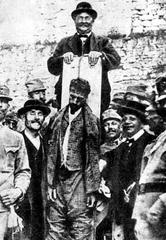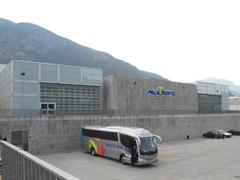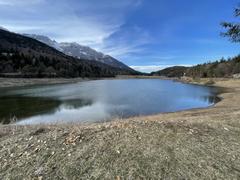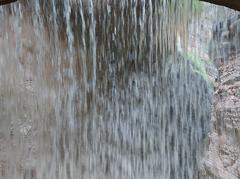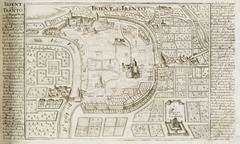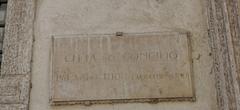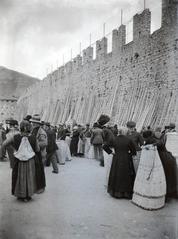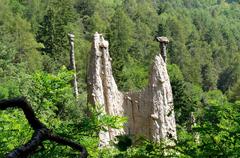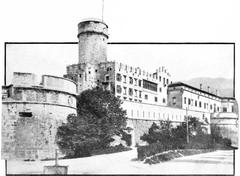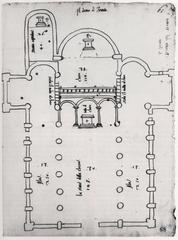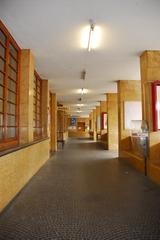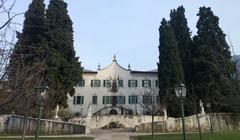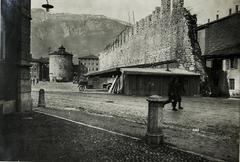Castel Vedro Fortress, Trento, Italy: Visiting Hours, Tickets, and Comprehensive Travel Guide
Date: 14/06/2025
Introduction: Castel Vedro Fortress—History and Cultural Significance
Set in the scenic Trentino region near Trento, the Fortress of Castel Vedro is a landmark of military ingenuity and regional history. Constructed primarily in the late 19th century under the Austro-Hungarian Empire, Castel Vedro was an integral part of the Fortress of Trento defensive system. Strategically positioned to control Alpine passes such as Valsugana and the Adige Valley, the fortress stands as a remarkable example of mountain fortification, featuring unique architectural elements like the Haxo casemate, multi-tiered artillery placements, and intricate underground galleries (Wikipedia: Fortress of Trento; Il Dolomiti).
The heritage of Castel Vedro traces further back, with its site serving military purposes since Roman times and evolving through medieval and modern fortification periods. The fortress today is partially restored and accessible via guided tours and special events, managed by the Ecomuseo dell’Argentario, which has led conservation efforts and opened trails, defensive structures, and wartime remnants to the public.
For travelers, Castel Vedro provides not only a dive into military architecture but also panoramic views and proximity to other historical Trento sites such as Buonconsiglio Castle and Trento Cathedral. This guide presents detailed historical context, practical visiting tips, ticketing, and accessibility information, ensuring a rewarding experience at this Alpine gem (Visit Trentino; cultura.trentino.it).
Table of Contents
- Fortress Overview and Historical Background
- Architecture and Defensive Features
- Visitor Information: Hours, Tickets, and Accessibility
- Guided Tours and Special Events
- Travel Tips and Nearby Attractions
- Restoration and Conservation
- Frequently Asked Questions (FAQ)
- Visual and Media Resources
- References and Further Reading
- Conclusion & Call to Action
Fortress Overview and Historical Background
Strategic Origins
Castel Vedro was built during heightened tensions between the Austro-Hungarian Empire and the Kingdom of Italy, forming a key part of the Fortress of Trento (Festung Trient) network. Its placement controlled crucial Alpine routes, providing strategic military advantage (Wikipedia: Fortress of Trento).
Construction and Evolution
Constructed between 1868 and 1876 by Francesco Ranzi and designed by Daniel von Salis da Soglio, the fortress utilized innovative vertical layouts and artillery protection methods, including the Haxo casemate. The site’s significance dates back to Roman and medieval times, evolving from an ancient castelliere and medieval castle (destroyed in 1254) to the robust modern structure seen today (Wikipedia: Complesso fortificato di Civezzano).
Defensive Complex
The fortress was designed to house up to 48 soldiers, with two tiers of artillery, deep moats, barbed wire, and covered trenches. Armaments included 15 cm and 9 cm cannons, later updated during World War I. Auxiliary defenses, such as the Tagliata Stradale Inferiore and Superiore, protected key roadways and featured rock-carved casemates and artillery emplacements (Wikipedia: Complesso fortificato di Civezzano).
Later History and Restoration
Although never engaged in direct combat, Castel Vedro was adapted for evolving military needs through WWI and WWII. After periods of abandonment, recent restoration by the Ecomuseo dell’Argentario has stabilized structures, reopened trails, and preserved historical features, making the site accessible once more (Il Dolomiti).
Architecture and Defensive Features
- Vertical Mountain Design: Maximized firepower and defense within a compact footprint by stacking artillery and garrison spaces.
- Haxo Casemate: Provided shelter for artillery while maintaining fields of fire.
- Auxiliary Tagliata Defenses: Roadblocks carved into the mountain, with casemated gun positions and barracks.
- Underground Galleries: Tunnels connect defensive positions and storage areas, many restored for visitor access.
- Multi-Tiered Artillery: Allowed overlapping fields of fire across the Valsugana valley and Fersina gorge.
Visitor Information: Hours, Tickets, and Accessibility
Visiting Hours
- Open: Primarily during special events and by guided tour (late spring to early autumn).
- Closed: Regular daily access is not available; check event calendars.
- Booking: Advance reservation is essential—visit the Ecomuseo dell’Argentario or Trentino Cultura websites for tour dates (cultura.trentino.it).
Tickets
- Admission: Free or nominal fee during events; guided tours may include a small charge.
- Purchase: Book through Ecomuseo dell’Argentario, local tourist offices, or online event calendars.
Accessibility
- Terrain: Steep, uneven, and partially restored; suitable footwear required.
- Mobility: Some areas may be challenging for wheelchair users, but organizers have improved key pathways.
- Facilities: Limited restroom and refreshment facilities; bring essentials.
Guided Tours and Special Events
- Guided Tours: Offer exclusive access to interior galleries, underground passages, and expert historical commentary.
- Languages: Primarily in Italian, with English or multilingual support available on request.
- Events: Look for cultural festivals and reenactments that animate the site’s military past.
Travel Tips and Nearby Attractions
- Getting There: Best reached by car to Civezzano; public transport limited, check bus schedules.
- Combine Visits: Explore Trento’s Buonconsiglio Castle, Trento Cathedral, and Lake Toblino for a full day of history and scenery.
- Photography: Panoramic views over the Valsugana valley; best light at sunrise/sunset.
- Safety: Bring a headlamp for underground sections (often provided).
Restoration and Conservation
- Conservation Efforts: Focus on structural stability, fresco and stonework preservation, and reopening historic trails (ICCROM Handbook).
- Community Involvement: Local artisans and educational programs contribute to ongoing care and public engagement.
Frequently Asked Questions (FAQ)
Q: How do I book a visit?
A: Reserve in advance through Ecomuseo dell’Argentario or Trentino Cultura.
Q: Are tours available in English?
A: Most tours are in Italian, but English support can be arranged—contact organizers ahead of time.
Q: Is the site child-friendly?
A: Yes, with supervision due to uneven terrain and underground areas.
Q: Accessibility for wheelchairs?
A: Some main paths are accessible, but not all interior areas.
Q: What should I bring?
A: Sturdy shoes, weather-appropriate clothing, water, snacks, and a flashlight for tunnels.
Visual and Media Resources
- High-resolution images and virtual tours are available via Visit Trentino and the Ecomuseo dell’Argentario.
- Sample alt text: “Castel Vedro Fortress artillery casemates and mountain views.”
References and Further Reading
- Wikipedia: Fortress of Trento
- Wikipedia: Complesso fortificato di Civezzano
- Il Dolomiti article on Castel Vedro
- Visit Trentino: Cultural Trails
- Cultura Trentino – Castel Vedro
- Architecture Lab: Castles
- ICCROM Conservation Handbook
Conclusion & Call to Action
The Fortress of Castel Vedro provides a unique perspective on Trentino’s layered history, blending military architecture, alpine scenery, and ongoing community-led restoration. For the best experience, plan your visit around special events or guided tours, take advantage of the panoramic photography spots, and spend time exploring nearby Trento sites for a complete cultural itinerary.
For up-to-date visiting hours, booking information, and interactive maps, download the Audiala app and consult the official resources listed above. Join in preserving and celebrating Trento’s remarkable heritage—your journey into history starts at Castel Vedro.

